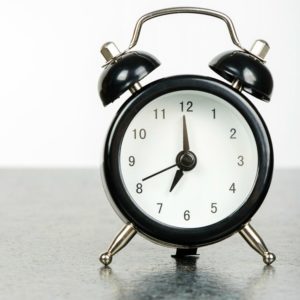 Flexibility.
Flexibility.
We know that’s what we need as moms. While businessmen have office doors to close and paper-based projects that stay put when they leave the room, we do not.
Our responsibilities revolve around people. Not just any people, either. Our people are growing, changing, learning all the time. What worked during one season doesn’t work the next. Add another baby and all the dynamics shift again on top of the lack of sleep.
Yet too often we confuse flexibility with spontaneity. The best way to be flexible, we assume, is to have no plan at all.
But that is not the best way to make the right choice at any given moment about what to do. Perhaps we won’t feel stressed about deviating from the plan, but that doesn’t mean the choice we make is the best one, the right one. So if we’re looking to grow in our ability to do the right next thing, then simply abandoning all forethought is not the way to go.
Instead, we need to begin at the end.

Beginning with the end in mind is habit 2 in Franklin Covey’s “7 Habits of Highly Effective People,” a book I read and loved in college. Beginning with the end in mind is envisioning what you want in the future so that you know specifically what you’re working toward. If you don’t know where you’re going, you’re not likely to get there.
I love double-meanings and layered meanings in phrases, and I think this one presents us with more than meets the eye if we examine it.
What is the end?
end, noun
- a final part of something, especially a period of time, an activity, or a story
- the furthest or most extreme part or point of something
- a goal or result that one seeks to achieve
Now, when Covey writes about beginning with the end in mind, I believe he is using the third meaning of “end” there – what is the goal we’re trying for? And that is important. But just as important are the other meanings.
Begin with the goal in mind
Flexibility is possible when we know the goal we’re seeking. When we know why we’re doing something, we can be open other other options that still move us toward our ends. We can loosen up on methods and practices when we know the result we’re after, because we see it’s less about the specific path laid out in our mind and more about the correct destination.
When we know our goal is children who love stories and have read many books, we can loosen up on the particular book list laid out ahead of time. We can even lighten up on how those books are read. Audio books in the car or while playing Legos move us toward the end just as much as a kid curled up on the couch with a paperback.
When we know our goal is a house that functions and provides a helpful stage for people to do their work, then the cleaning that is necessary for that end is less about the cleaning routine or the clean state and more about allowing people to do their work without fear of “messing up” the cleaning. The cleaning is for the people, not the people for the clean house.
Begin with the extreme point in mind
Flexibility is possible when we are both living in the present moment while also being aware of the point in the future we are heading. The choices that we make now – flexibly or not – move us toward a certain destination.
Beginning with the end in mind is about knowing our priorities up front, so when we must adapt or make a choice, we can choose based on which feeds our priorities rather than which is most convenient or attractive in the moment. It gives us a lens through which to filter our decision about whether or not to freak out, whether or not to jump ship, whether or not to stay the course.
Begin with the final story in mind
Flexibility is possible when we can see ourselves in the story that’s playing out around us – not just the story with ourselves as the main character, but also who we are in the stories of our children, husband, and friends. If this were their story, and we were side characters, what would our character sketch look like? Who do you want to be in their story? What would that sort of character do?
Sometimes seeing situations through the lens of story helps give us that perspective that we so desperately need. We need to be able to pause and reflect rather than act impulsively and instinctually. And viewing our circumstances and our as a story is a simple yet effective way to interpret what should be done.
Of course, to be flexible with you plan, you have to have one in the first place and be looking at it regularly. Planning with an open hand can be so difficult, but it’s the only way to function with resilience as a mother. We are not ultimately in charge, yet we are called to steward. Work the Plan shows you how to create and use a plan with a flexible, open-handed attitude – in a way that actually works for our lifestyles as intentional, involved mothers.

Work the Plan is now included in Membership!
- Get gospel-focused advice and encouragement.
- Level up your plans and progress, one step at a time.
- Find accountability with likeminded women without any social media drama.
- Experience the homemaking mentoring you’ve always wanted.
- Learn to love being a homemaker!

